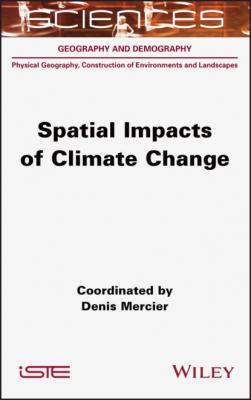Spatial Impacts of Climate Change. Denis Mercier
Читать онлайн.| Название | Spatial Impacts of Climate Change |
|---|---|
| Автор произведения | Denis Mercier |
| Жанр | География |
| Серия | |
| Издательство | География |
| Год выпуска | 0 |
| isbn | 9781119817901 |
According to sources, the cryosphere on Earth occupies more than 36 million km2, or 24% of the continents. Depending on the season, the marine cryosphere covers between 19 and 28 million km2, or 5.3 to 7.8% of the ocean surface. The continental cryosphere mainly represents 30.2 million km3 of freshwater, which represents a potential theoretical sea level rise of 74 m (65 m for Antarctica, 7 m for Greenland, 1.1 m for permafrost, 24 cm for mountain glaciers, and less than 1 cm for snow; see Table 2.1 and Francou and Vincent 2011). However, since much of the cryosphere is a multi-millennia legacy, some of its components are not subject to contemporary climate change. For example, the Antarctic continent has been frozen for millions of years, since plate tectonics placed it in a polar orbital position, and a huge part of its 27 million km3 of ice is fortunately unaffected by contemporary warming. However, the sensitivity of the Greenland ice sheet is greater because of its smaller size and its position in the heart of the Arctic, which is particularly affected by current warming (see Chapter 1).
Table 2.1. The components of the cryosphere. The marine cryosphere is not included in this table because the melting of the sea ice does not induce sea level rise
(source: Francou and Vincent 2011)
| Cryosphere component | Surface area in km2 | Volume in km3 (water equivalent) | Sea level equivalent (the surface of the oceans represents 361 million km2) |
| Antarctica | 12.4 million | 27 million | 65 m |
| Greenland | 1.8 million | 2.7 million | 7 m |
| Permafrost | 23 million | 0.24 million | 1.1 m |
| Mountain glaciers | 0.43 million | 0.08 million | 0.24 m |
| Snow | 4 to 46 million | 500 to 5000 | 0.1 to 1 cm |
Figure 2.1. Extension of the cryosphere. For a color version of this figure, see www.iste.co.uk/mercier/climate.zip
(source: © Hugo Ahlenius, UNEP/GRID-Arendal)
The cryosphere is highly sensitive to climate change for two physical reasons. The first is the increase in surface air and seawater temperatures, which induces a transition from solid to liquid state. The second reason is correlated with the increase in air temperatures, which induces a decrease in solid (snowy) precipitation, which contributes to a reduction of the mass balance of glaciers of all sizes.
Moreover, the cryosphere is sensitive to the fundamental role played by albedo. The bright surfaces of the marine and terrestrial cryosphere reflect a significant proportion of solar radiation (see Chapter 1). Snow reflects 75-95% of the sun's energy, glaciers 40-60%. The reduction of these areas with a high albedo potential automatically leads to an increase in areas that absorb more solar radiation and, through a positive feedback loop, contribute to the warming of the lower layers of the atmosphere.
2.3. Melting of the marine cryosphere
2.3.1. The melting of the Arctic sea ice
Between 1979 and 2019, the Arctic sea ice lost 12.9% of its surface area per decade, representing a loss of half of its surface area by the end of the melt season (see Figure 2.2). As a result, in September 2019, Arctic sea ice occupied just over 4 million km2, compared to almost 8 million km2 in 1979. This trend represented a loss of 82,400 km2 per year between 1979 and 2019. Beyond this four-decade trend,
Figure 2.2 shows that the melting of the sea ice has in fact slowed over the last 13 years (2007-2019).
The year 2012 corresponds to the year when the reduction in the ocean surface area covered by Arctic sea ice was the most marked in the last 40 years (see Figures 2.2 and 2.3). It was mainly visible along the Siberian coast, clearing the Northeast Passage. Similarly, the sea ice disappeared from the Beaufort Sea along the coasts of Canada and northern Alaska in the summer of 2012. Sea ice still occupies the oceanic part between the North Pole, northern Greenland and Ellesmere Island, for atmospheric and oceanic reasons related to the Beaufort Gyre. This spatial asymmetry in the extension of the Arctic sea ice is increasing with contemporary global warming.
Figure 2.2. Average Arctic sea ice extent for the month of September between 1979 and 2019. Decade of decline of 12.9%. For a color version of this figure, see www.iste.co.uk/mercier/climate.zip
(source: National Snow and Ice Data Center).
Figure 2.3. Spatial extent of Arctic sea ice as of September 1, 1980, and on September 1, 2012, the year in which the extension was the least in the last four decades. For a color version of this figure, see www.iste.co.uk/mercier/climate.zip
(source: The Cryosphere Today)
In addition to the loss of surface area, the average thickness of the Arctic sea ice has decreased by half, from 3 m to 1.5 m. This is due to the spatial reduction of multi-year sea ice in favor of the young annual sea ice (AMAP 2017). Thus, the younger, thinner Arctic sea ice is also more fragile, more brittle, and more easily displaced from the Arctic Basin via Fram Strait by transpolar drift (see Figure 2.4). This positive feedback loop helps to understand the evolutionary process of this reduction in the spatial extent of Arctic sea ice (Weiss 2008). According to the latest IPCC report (IPCC 2019), the proportion of multi-year ice that is at least five years old decreased by about 90% between 1979 and 2018.
